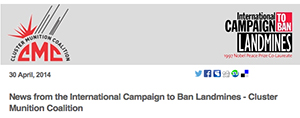29 November 2012
Landmine use by governments at low point, mine clearance funding at record level; assistance to landmine survivors still a challenge
Press Release -- Geneva, 29 November 2012: Only one government - Syria - has used antipersonnel landmines in 2012, matching the lowest point since the signing of the 1997 Mine Ban Treaty, according to Landmine Monitor 2012. Four governments used antipersonnel mines in 2011 (Israel, Libya, Myanmar, and Syria).The number of governments rejecting antipersonnel mines continues to grow, with three new countries - Finland, South Sudan, and Somalia – joining the Mine Ban Treaty since July 2011. The succession of South Sudan and accession of Somalia means that all sub-Saharan African countries have joined the Mine Ban Treaty. Globally, 160 countries are party to the treaty, more than 80 percent of all countries.
“The low in antipersonnel landmine use by states this year, the all-time high in mine clearance funding in 2011, and the dramatic reduction in landmine casualty rates compared to one decade ago is a testament to the achievements of the Mine Ban Treaty over the past 15 years and that’s the good news,” said Mark Hiznay, editor of Landmine Monitor 2012. A total of 4,286 new casualties from landmines and explosive remnants of war were recorded in 2011, or approximately 12 casualties per day versus 32 casualties per day in 2001.In some of the countries most affected by landmines and explosive remnants of war (ERW) such as Afghanistan, Cambodia, and Colombia, the report notes real progress in reducing the number of casualties and human suffering.However, the report also highlights new challenges including a significant increase in casualties in countries such as Libya, Sudan, South Sudan, and Syria, a decrease in international funding for victim assistance projects, and landmine use by non-state armed groups in six countries, up from four in the previous report. Moreover, the continued high number of requests by States Parties to the Mine Ban Treaty for mine clearance deadline extensions is a matter of serious concern.International and national funding for mine action in 2011 was the largest combined total ever at approximately US$662 million, or $25 million more than in 2010. Despite this record total, earmarked funding for victim assistance decreased by 30% from 2010, the lowest level since the Monitor began reporting on such funding in 2007.“While the annual rate of new casualties has decreased greatly during the past decade, the total number of survivors in need of victim assistance has continued to grow around the world each year," Hiznay said. "Yet the promise of the Treaty to adequately address the rights and needs of the hundreds of thousands of survivors must be fulfilled. This continues after the stockpiles have been destroyed and clearance completed."Additional key findings from the report include:• Eighty-seven States Parties have officially declared completion of stockpile destruction, collectively destroying more than 46 million stockpiled antipersonnel mines.• Three States Parties remain in violation of the treaty, failing to complete destruction of stockpiles within a four-year deadline - Belarus, Greece, and Ukraine.• Thirty-seven mine action programs world-wide destroyed more than 325,000 antipersonnel mines and nearly 30,000 antivehicle mines, releasing in the process over 190km2 of territory.• Challenges to availability and accessibility of assistance and services for survivors were identified in at least 12 countries in 2011, primarily due to declining international assistance and new or intensifiedconflicts.• A total of 19 States Parties have reported completion of their obligation to clear areas containing antipersonnel mines. Of the other 45 States Parties with outstanding obligations identified, 27 have been granted at least one extension period.The Monitor is the research arm of the International Campaign to Ban Landmines - Cluster Munition Coalition (ICBL-CMC). The ICBL was awarded the 1997 Nobel Peace Prize for its work to eradicate landmines. The Monitor is coordinated by five non-governmental organizations - Action on Armed Violence, Handicap International, Human Rights Watch, Mines Action Canada, and Norwegian People’s Aid.“In spite of the great gains made over the past 15 years toward achieving a mine-free world, eliminating the daily impact landmines have on countless communities will require a sustained international effort for years to come,” said Hiznay.Landmine Monitor 2012 will be released on 29 November by the International Campaign to Ban Landmines in advance of the Mine Ban Treaty’s 12th Meeting of States Parties, taking place at the United Nations in Geneva from 3-7 December.Links:• Landmine Monitor 2012 and related documents will be available after 10am GMT+1 at http://www.the-monitor.org/index.php/LM/Press-Room/Landmine-Monitor-Media-Kit on 29 November.• Detailed individual country profiles for all countries of the world and seven other areas are available at www.the-monitor.org/cp.ENDSFor more information or to schedule an interview, contact:• Jared Bloch, ICBL-CMC Media and Communications Consultant, Geneva (GMT+1), mobile +41-78-683-4407, +41-22-920-03-20, email jared@icblcmc.org• Kathryn Millett, Landmine and Cluster Munition Monitor Coordinator, Geneva (GMT+1), mobile+41-79-455-5527, +41-22-920-03-20, email kathryn@icblcmc.org


